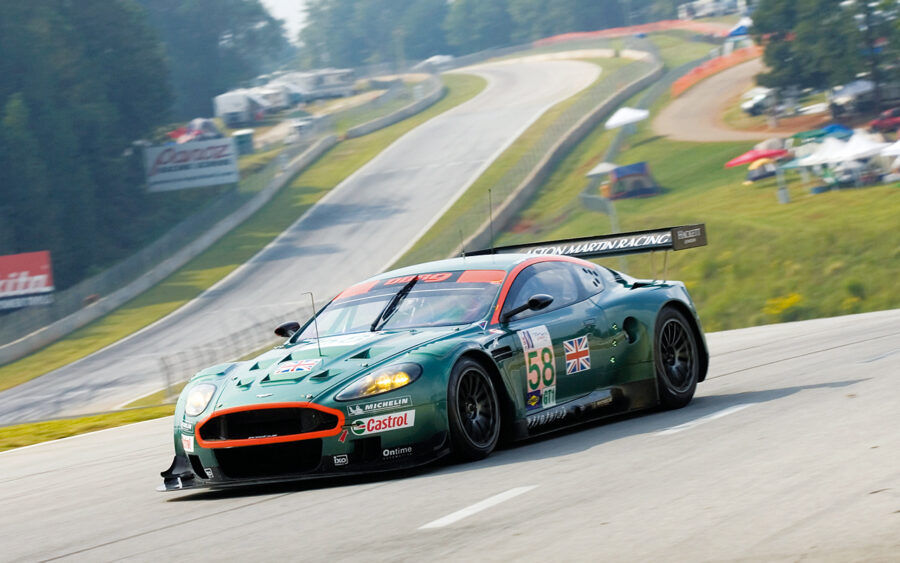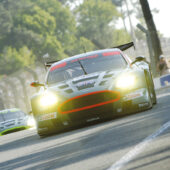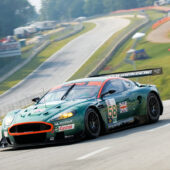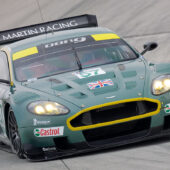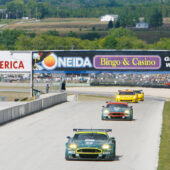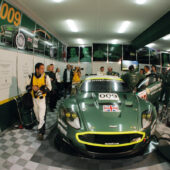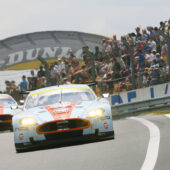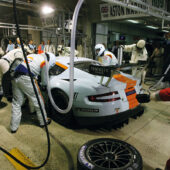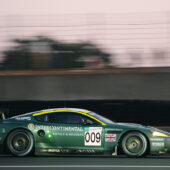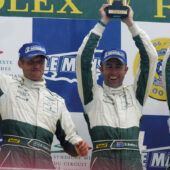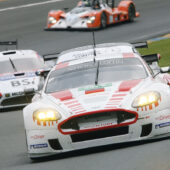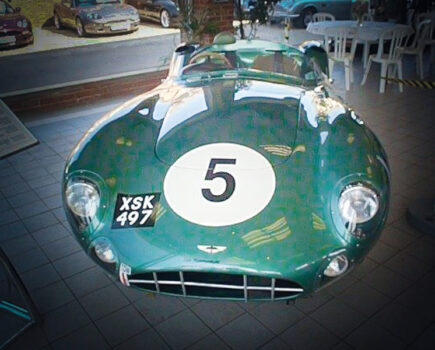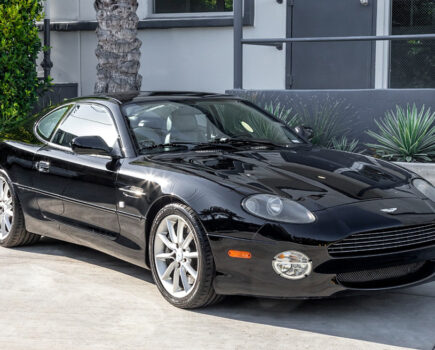We explore the history of the car that returned Aston Martin to the top of the Le Mans rostrum in 2007 and 2008: the magnificent DBR9
Words: Matt James
With Audi taking 13 wins in the first 15 years at Le Mans since the turn of the century, the fight for top honours at Le Mans was very often simply an intra-team battle. Excitement came from the other classes and prime among them was the GT1 battle. Aston Martin took back-to-back wins in the glorious DBR9 in 2007 and 2008, fending off the rumbling Corvette squad on both occasions. The 6.0-litre V12 had first been introduced in 2005 as Aston sought to re-establish its competition credentials and commercial success. The car’s type number was a clear nod to the Aston Martin DBR/1, which had claimed outright victory at Le Mans in 1959.
The carbon fibre competition DBR9 machine was a meaner, more focused take on the svelte DB9 recipe, capable of pushing out 625bhp and run by Prodrive with input from the Aston factory. It shook the establishment with victory in the Sebring 12 Hours in 2005 and an impressive fourth overall on its debut and the fans in racing green were licking their lips in anticipation of a raft of success.
Driver Darren Turner, who had driven with Prodrive for the two previous seasons in a Ferrari 550 LM GTS, was there for the gestation period of the DBR9. “I was in at the start of the Aston project insomuch as I could have an input into the car,” he explains. “Even before it was built, I was able to tell them the parts in the cockpit which were critical for the drivers in terms of the ergonomics and I could also tell them what was not so necessary. I went through all of that kind of stuff with the design team.”
When the car first did hit the circuits, it was a winter’s day at Donington in early November 2004 and the initial impressions were good. Given Prodrive’s expertise, the rear-wheel-drive car was never going to be too far from the ultimate pace, but even Turner was surprised. “It was just a general shakedown and we didn’t expect too much from it really,” explains the now 48-year-old, who still races an Aston Martin in the British GT Championship.
“We thought that if we got ten laps under our belt, then that would be fantastic. It was one of those days when we realised it was going super well and we pounded around and around. The speed was good, we knew it felt lovely and we were straight away in the right ballpark. Like anything, there are obviously things you learn on day one that you then apply to it. And that was the same throughout the life of the car. But if you think about the DBR9, it went from 2005 through to, effectively, the end of 2011. We had seven years with it and with all the various upgrades were eventually able to make it better but we certainly hit the ground running with it. Straight out of the box, it was a pretty special car.”
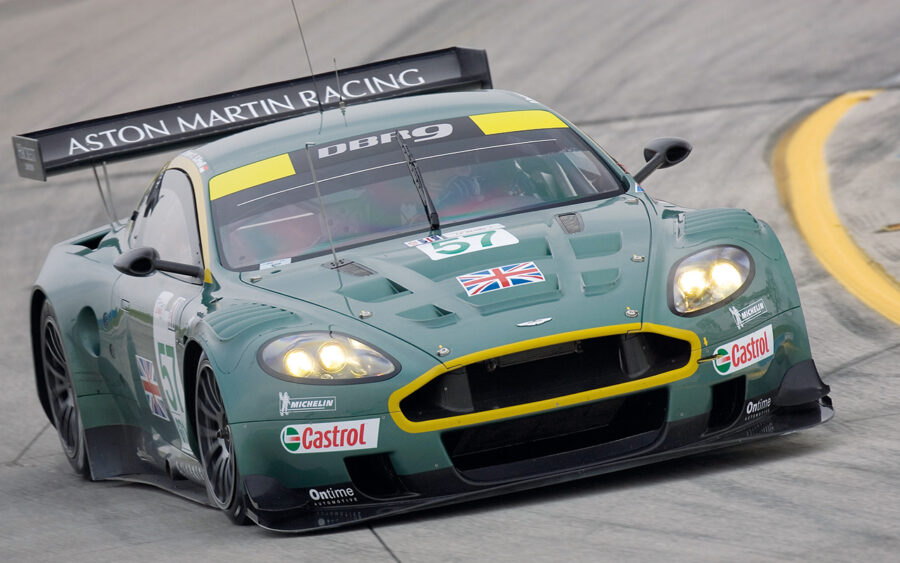
DBR9 at 12 Hours of Sebring, 2005
The initial victory at Sebring in March 2005 was a real marker for the opposition. Not only had the car run faultlessly on the highly demanding and less-than-smooth asphalt of the Florida track, but Aston Martin had poked a finger at the GT1 division dominators, Corvette. The American firm had much more funding than the plucky British operation, and the Chevrolet squad had been the benchmark in previous seasons.
David Brabham, son of the three-time F1 champion Sir Jack , helmed the car alongside Turner and French sports car ace Stéphane Ortelli. Brabham remembers the victory causing a few raised eyebrows in the GT racing world.
“We went and did the 12-hour race . The car was fast and it was reliable which shocked us as much as it did the opposition,” explains the Australian. “We weren’t really expecting it to be trouble-free and it was a great joy for me to be able to cross the line and win. The team was stoked about that result. To do it in Corvette’s backyard just made it even more satisfying.”
It takes time to unlock all the secrets from any competition car, especially one so new, but there was one factor which would prove to be a real Achilles heel for the DBR9. The front-engined format, coupled with the positioning of the exhausts, meant that temperatures inside the cabin became almost unbearable for the men at the controls. In a sports car, race drivers can be expected to be at the wheel for anything up to four hours at a time so maintaining concentration is paramount. Anything that can possibly hinder that is something that needs to be eradicated.
Brabham explains: “After we did Sebring, I told the team that the car was simply too hot . It was way over the top. As you can imagine, drivers complaining about the heat didn’t really go down too well with the management.
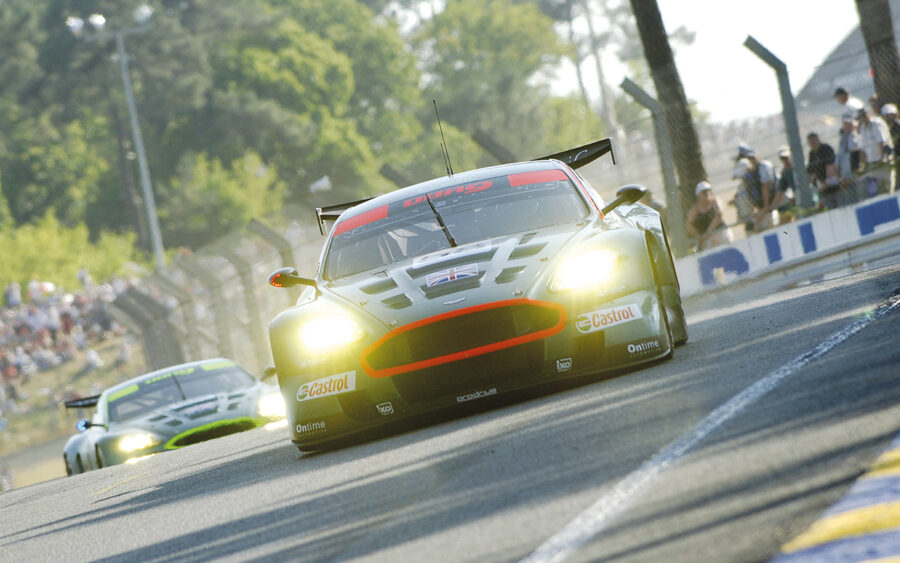
The two DBR9s at Le Mans 2005
“They had lots to focus on but I think there was a bit of a mentality issue there too: they would turn around and just say ‘well, get fitter then!’ It wasn’t quite that simple…we were getting cooked. We went to the Le Mans test day and I seemed to be the only one making a fuss about the temperature inside the car. All the other drivers would complain internally to each other but not to the management because they were worried about what the management would say. I knew the drivers were going to get too hot and that would inevitably lead to mistakes.”
And that was perhaps the downfall of the first attempt at the 24 hours race in 2005. The sweltering hot mid-June weekend didn’t help matters. And nor did the fact that extra insulation that the engineers had promised they would install around the power plant before the French classic failed to materialise. Brabham was perplexed to find that the only measure that had been taken was the supply of cool suits for the drivers.
“All three drivers in our car suffered really badly,” explains Brabham, “My right calf muscle just ripped apart and I couldn’t drive or walk. Darren Turner had a massive blister on his foot so he could hardly drive, and Stéphane Sarrazin had double vision. Luckily, the car had a front radiator leak and so they had to stop the car for a while to fix that and that gave us all some respite. The only one who could get to the finish was Stéphane , who said his vision returned to normal – whether it had or not, I really don’t know.”
The return to Le Mans had even started badly for Aston. Turner was given the driving duties for the opening stint and collected a penalty in the first couple of hours, which resulted in further problems.
“My penalty was a one-minute stop in the pitlane,” he explains, “and they wouldn’t even let me open the doors. I went to get some ventilation in it and the French officials said ‘non’. I was sat there with the engine off and there was a full heat soak going through the car. I was already massively hot in there. After that, when I got going and got to the first chicane on the Mulsanne Straight, I was feeling very woozy and I couldn’t really make out what was going on and I went off. That was purely down to what my body had been going through. It wasn’t the best experience.”
Those weren’t the only dramas, because a broken splitter – a legacy of Turner’s off and something which wasn’t discovered until quite late on in the race – and then that radiator leak left them trailing the two factory Corvettes.

Enge, Piccini and Turner finish sixth overall at Le Mans 2006
“We were double-stinting despite the discomfort in the car,” recalls Brabham. “I remember going out in the morning. I jumped in and the guy who was there to help belt you in to the cockpit pointed out that I had forgotten to put my cool suit on because I was tired, exhausted and just too out of it. I just looked at him, pushed him out of the cockpit, shut the door and off I went.
“On the radio, they said to me that if I didn’t feel up for doing a double stint, I should let them know. I felt like I could do it and when I came in for my pitstop, which was just fuel and no tyres, the door flung open and they unzipped the top of my race suit, stuffed a load of ice down my front, zipped me back up and off I went…
“I went ballistic after that race and I wrote a letter to Prodrive giving my thoughts. I figured I would get fired after that, but I wasn’t and quite a few of the guys realised that being straight was needed. They realised they needed to prioritise the drivers a bit more.”
The Aston Martin Racing drivers might have suffered the worst in the sweltering temperatures, but they weren’t the only ones in strife and the rule makers took notice. Following on from that scorcher in 2005, regulations were drawn up to make sure the cockpits stayed below a certain level and air-conditioning was mandated in all the GT1 machines.
With a nicer car to drive for its occupants, the DBR9 really began to make a mark on GT racing. After a defeat to Corvette in 2006, Aston finally returned to the top step of the podium at Le Mans in 2007, when Rickard Rydell, Turner and Brabham finished a lap ahead of Chevrolet in a remarkable fifth position overall. It was a feat repeated in 2008 when Antonio Garcia joined Turner and Brabham for a tense win over the Corvette.
By this stage, there had been further refinements to the chassis and there were a phalanx of customer teams racing the DBR9 around the globe. A Larbre-run DBR9 won the Le Mans Series GT1 class in 2006 in the hands of Vincent Vosse, Gabriele Gardel and Pedro Lamy and Aston claimed the manufacturers’ title in the same season in the FIA GT Championship against the mighty Maserati MC12 GT1.
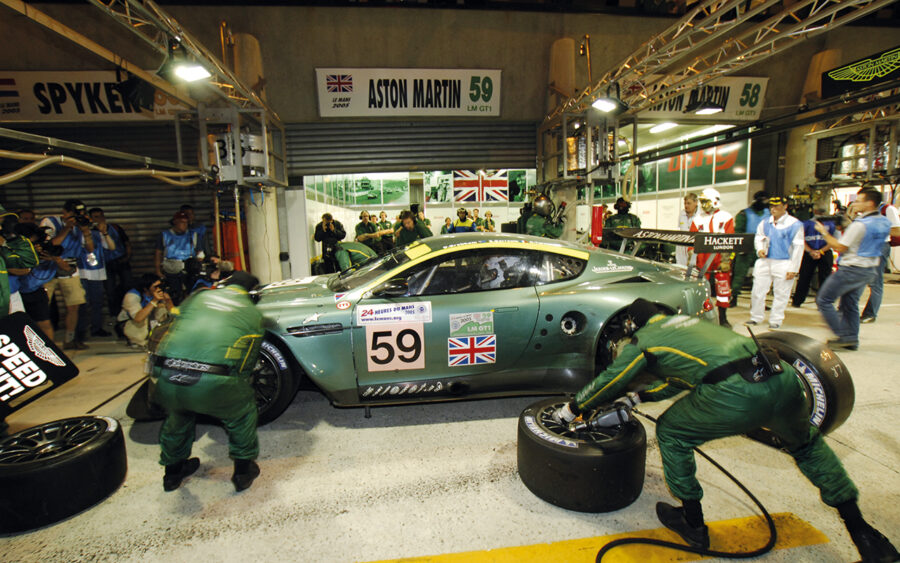
A late night pitstop at Le Mans in 2005
The car raced in the top flight through until the end of 2011, when the rulebook was rewritten and what had been running as the second tier – GT2 class cars – were promoted up the ladder to become the GT1 class. Aston had already introduced the V8 Vantage at that point and it became the focus of the British firm’s long-distance activities, but the memory of the DBR9 remains strong with all that were lucky enough to race it.
“I think with the aero set-up that it had for Le Mans – which was different to the sprint races – it was such a nice car,” remembers Brabham. “It was well balanced and a real joy to drive. You could just push and push and push and it felt like it wasn’t going to snap or bite you back.”
Turner’s history and his part in creating that Aston Martin legacy was something that he still cherishes dearly to this day. “The DBR9 is my favourite race car of all time. It is the one car that I had a really personal relationship with. To have been part of its journey from day one was pretty special right through to when we finished in 2011 and getting the two wins at Le Mans with it,” he explains.
“It had a very user-friendly V12 engine which had loads of torque and the handling aspect was also very driver friendly. It didn’t do anything which was really on a knife-edge, it gave you confidence. It wanted you to grab hold of it and wring its neck. You were never tentative getting in the car.
“It had the power and it had the downforce that you wanted. It had a sequential gearbox too and you felt really engaged with all the aspects of driving the thing. It had almost an old-school feel to it. Modern GTs with a paddleshift and ABS aren’t quite the same. They are still amazing fun to drive but GT1, in its heyday, was so amazing because you had to do so much behind the wheel. It was super engaging.
“I loved everything about it: the power, the looks, the sound and it was fast. It is the one car that if I was ever in the fortunate enough position to be able to buy one of my race cars back, it would be the one that I would seek out.”

